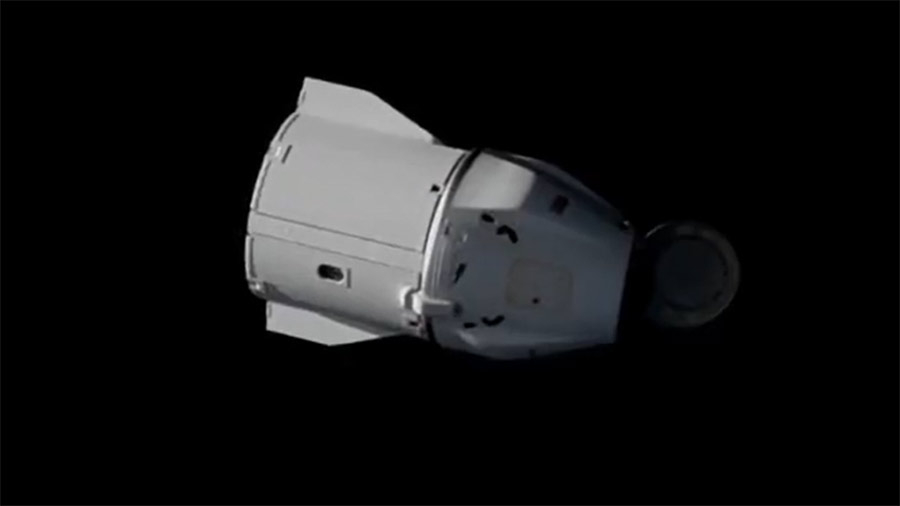SpaceX Dragon cargo ship undocks from space station for trip back to Earth
The Dragon spacecraft will splash down off the Florida coast on Monday, Jan. 24.

A SpaceX Dragon cargo ship is headed back to Earth.
The uncrewed Dragon CRS-24 resupply ship undocked from the International Space Station on Sunday (Dec. 23) after just over a month linked to the orbiting laboratory. The spacecraft, laden with more than 2 tons of gear, cast off from the station at 10:40 a.m. EST (1540 GMT) after a two-day delay due to landing site weather. The spacecraft is set to splash down off Florida's western coast on Monday.
"Dragon separation confirmed," NASA astronaut Tom Marshburn radioed Mission Control from the station as the SpaceX capsule undocked. Dragon and the station were sailing high above the South Pacific Ocean at the time.
Related: Live updates from the International Space Station
SpaceX's Dragon CRS-24 cargo ship is scheduled to splash down in the Gulf of Mexico off the coast of Panama City, Florida at 4:05 p.m. EST (2105 GMT) on Monday afternoon, although the landing will not be broadcast, NASA officials said. The spacecraft is carrying more than 4,900 pounds (2,200 kilograms) of science experiment results and other station gear back to Earth.
"Expedition 66 wishes the Dragon well on its return," Marshburn told Mission Control on behalf of the station's current Expedition 66 crew. "Congratulations to Houston and SpaceX. Can't wait to see what the results bring."
SpaceX launched the Dragon CRS-24 cargo ship on Dec. 21 to deliver more than 6,500 pounds (2,900 kg) of supplies, science gear and other hardware. It arrived at the station on Dec. 22 to complete its delivery, which also included some Christmas treats for the station crew.
Breaking space news, the latest updates on rocket launches, skywatching events and more!
The Dragon spacecraft has visited the space station before. SpaceX used it to deliver cargo for NASA on the CRS-22 delivery mission in June 2021. Once it returns to Earth Monday, SpaceX teams will retrieve the capsule with recovery ships and deliver its science and cargo haul to NASA.
Some of that cargo returning to Earth includes some much anticipated science results. Packed aboard the capsule are results from a study called "Cytoskeleton" to study how weightlessness affects the cells of mammals, science that could one day help astronauts on long-duration space missions. The results from another study, called InSpace-4, may help scientists develop new ways to use nanoparticles to build new materials for spaceflight.
One old item making a return to Earth is the Light Microscopy Module, or LMM, a once state-of-the-art imaging microscope that has been aboard the space station since 2009. It is now being retired from service.
"Sponsored by NASA's Biological and Physical Sciences division, this powerful diagnostic tool enabled novel research of microscopic phenomena in microgravity, providing the capability to remotely acquire and download images and videos at many levels of magnification," NASA officials wrote in a statement. "LMM made it possible to observe and record the way matter is organized and moves on the microscopic level."
While NASA will not broadcast the descent and splashdown of the Dragon CRS-24 cargo ship, you will be able to follow its progress online. NASA will post updates on the spacecraft's return on its space station blog. SpaceX is also expected to post an update on its Twitter page with the splashdown results Monday afternoon.
Correction: A previous version of this story misstated the docking date for SpaceX's CRS-24 Dragon. It arrived at the International Space Station on Dec. 22, not Dec. 23.
Email Tariq Malik at tmalik@space.com or follow him @tariqjmalik. Follow us @Spacedotcom, Facebook and Instagram.

Tariq is the award-winning Editor-in-Chief of Space.com and joined the team in 2001. He covers human spaceflight, as well as skywatching and entertainment. He became Space.com's Editor-in-Chief in 2019. Before joining Space.com, Tariq was a staff reporter for The Los Angeles Times covering education and city beats in La Habra, Fullerton and Huntington Beach. He's a recipient of the 2022 Harry Kolcum Award for excellence in space reporting and the 2025 Space Pioneer Award from the National Space Society. He is an Eagle Scout and Space Camp alum with journalism degrees from the USC and NYU. You can find Tariq at Space.com and as the co-host to the This Week In Space podcast on the TWiT network. To see his latest project, you can follow Tariq on Twitter @tariqjmalik.

